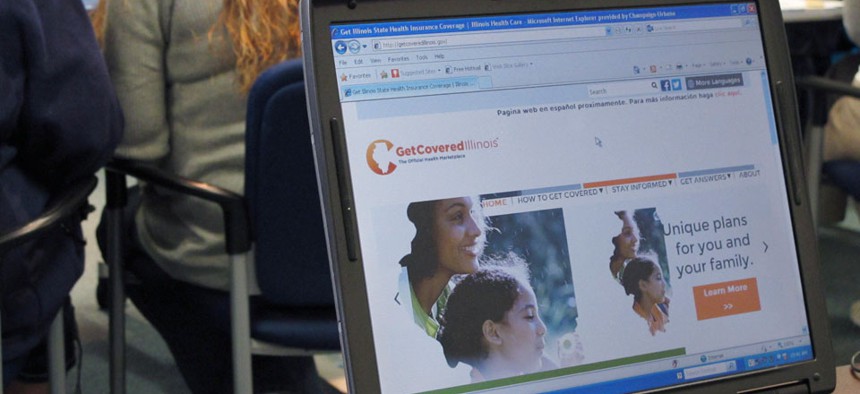Why States Are Doing Obamacare Better

Illinois' Get Covered site is shown Oct. 1. David Mercer/AP
The main variable appears to be who's running it.
A small—and somewhat surprising—handful of states are implementing Obamacare much more effectively than the Obama administration.
HealthCare.gov, the federally run website to sign up for coverage in most of the country, remains plagued by problems: Many consumers still can't use the site three weeks after its launch, and insurance companies are sometimes getting incorrect information about the trickle of enrollees who do get through.
But in a couple of states, things are looking better. Their insurance marketplaces are humming along, or at least overcoming early technical issues. Some are reporting accurate information to insurance companies.
So what did those states do right that the Health and Human Services Department did wrong?
Several factors separate HealthCare.gov from the state exchanges getting the best reviews, which include the marketplaces in Kentucky, Rhode Island, and Washington state. But health care experts say they boil down to this: HHS had neither a good plan nor appropriate oversight of its contractors.
"Management—that's it," said Bob Laszewski, a health care consultant who works closely with insurers.
He said the fact that at least a few states could build successful exchanges rules out some of the factors blamed for flaws in HealthCare.gov, such as regulations that weren't released until after last fall's elections.
The 14 states that chose to run their own exchanges had basically the same pool of contractors as HHS—along with a supply of federal grant money, the same deadlines, and the same underlying law, Laszewski said.
"There's only one variable—who's running it," he said.
It's also hard to ignore the fact that some of the most troubled state-run exchanges signed big contracts with CGI—the company that's in the hot seat over HealthCare.gov's failures. The Canadian company was the primary contractor for new marketplaces in four states: Colorado, Hawaii, Massachusetts, and Vermont.
Health care experts consider Hawaii one of the worst state-run exchanges in the country. It only began to display information about health care plans last week, a full 15 days behind the Oct. 1 deadline.
In Vermont, consumers can compare their policies online, but they can't actually buy one. State officials delayed the sign-up process until at least November, because their testing showed that the technology simply didn't work.
"I think I've made my frustration with what doesn't work very clear," Vermont Gov. Peter Shumlin, a Democrat, said this week, according to a local newspaper. "It's frustrating. When we pay for a product I expect it to work. I've made that very clear to the CEO of CGI, I'm going to hold their feet to the fire until it's perfect."
Colorado got off to a rough start as well, although its site appears to be improving. Just 305 people had signed up for coverage through Colorado's exchange a week after it opened.
It is unclear whether CGI's clients faced delays because of problems with the company's work. A source familiar with the state exchanges said delays in Hawaii and Vermont were caused by the compressed time frame of the contracts—the company had 10 months to finish its work in Hawaii and less time in Vermont—and the ambitious nature of the projects.
Ultimately a contract with CGI may not be the deciding factor in an exchange's success or failure. The company was a subcontractor for Kentucky's successful exchange, although it built different parts of the system there.
Before the Oct. 1 launch date, all eyes were on states like Maryland and California—solid blue states where Democratic governors enthusiastically embraced the Affordable Care Act and made clear that they intended to be leaders in the implementation effort.
States like Kentucky ended up faring better in part because they built smaller, more efficient systems rather than aiming for a dramatic new marketplace full of bells and whistles, an insurance industry official said.
Kentucky also credited its success with the fact that it built the exchange within an existing state agency, keeping the operation small and focused.
"We kept the design as clean as possible to ensure fast load times and we made sure the content was only what was necessary and written at a very low reading level—keeping the process as simple as possible was our guiding principle," said Gwenda Bond, a spokeswoman for Kentucky's Cabinet for Health and Family Services, which built the exchange.
Critical structural choices helped ease the process in the rough opening days. Some states, including Kentucky and Rhode Island, allowed consumers to shop for insurance before making their way through the longer process of creating an account. HealthCare.gov required an account—and that was the first process to break, as soon as the site launched.
Exchanges that let consumers start shopping immediately were far better equipped to handle their traffic and begin actually enrolling people.
HealthCare.gov has added a basic comparison feature since launching. Although some developers scratched their heads at the initial design decision, the site's ongoing dysfunction at this point seems like "an implementation problem, not a design problem," said Caroline Pearson, a vice president at the consulting firm Avalere Health.
"There's no defining design feature that's making them work better than HealthCare.gov," she said.
NEXT STORY: Get Ready for a New Digital Land Grab





